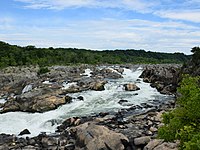
Photo from wikipedia
Abstract Low-temperature thermochronology is used widely in the Tibet plateau uplift. Some researches, however, have defined the time of rapid denudation as simply rock uplift and have neglected the fact… Click to show full abstract
Abstract Low-temperature thermochronology is used widely in the Tibet plateau uplift. Some researches, however, have defined the time of rapid denudation as simply rock uplift and have neglected the fact that the rock denudation recorded by fission track (FT) data was controlled by both surface incision and rock uplift. The incision of the Yarlung Zangbo River had a significant influence on uplift history inversion in Southern Tibet. This paper simulated the bedrock denudation and river incision histories using apatite fission track (AFT) data sampled from the Gangdese conglomerate belt, which is located in the middle of Southern Tibet, and analyzed the geological meaning of the AFT age of each sample. The results showed the following: (1) In the early Miocene (22–16 Ma), both the value of the denudation rate and the incision rate were high (0.56 mm/yr and 0.24 mm/yr). (2) In the middle-late Miocene, the incision rate (0.12 mm/yr) was similar to the denudation rate (0.09–0.11 mm/yr). (3) The historical model between river incision and bedrock denudation revealed a significant difference in the denudation rate during the period ca. 8–6 Ma. Combining these data with previously published thermochronological ages and synthesizing these ages with regional geological, we arrived at the following conclusions: (1) In the early Miocene, the denudation event probably was caused by a combined result of Indian plate rollback and the incision of the Yarlung Zangbo River. (2) In the middle-late Miocene, the denudation rate was consistent with the incision rate, which suggested that the denudation episode was caused by climate change associated with Asian monsoon intensification. (3) After 8 Ma, the stable and slow incision rate indicated that regional drastic uplift had ceased. The paleo-elevation of the research area had approached, and even exceeded, the present-day elevation in the late Miocene.
Journal Title: Journal of Asian Earth Sciences
Year Published: 2018
Link to full text (if available)
Share on Social Media: Sign Up to like & get
recommendations!